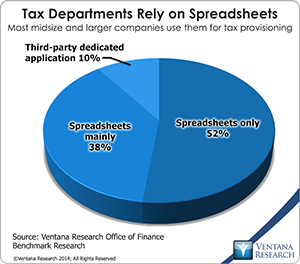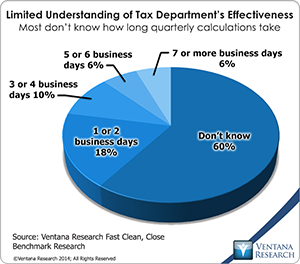I’ve written before about the increasing importance of having a solid technology base for a company’s
In this context of seriousness, there are five interrelated requirements for the work that tax departments do:
- The work must be absolutely accurate.
- Corporate and tax executives must be certain that the numbers are right – instilling confidence is key.
- Certainty depends on transparency: Source data and calculations must be demonstrably accurate, and any questions about the numbers must be answerable without delay.
- Speed is critical. All department tasks related to tax planning, analysis and provisioning can become sources of delay in core finance department processes. Being able to quickly execute data collection and calculations allows more time to explore the results and consider alternatives.
- Control of the process is essential. Only particular trustworthy individuals can be permitted to access systems, perform tasks and check results. Control promotes accuracy, certainty and transparency.
 These requirements form the basis of a business case for a tax data warehouse. Properly executed, it promotes all of these qualities. However, our forthcoming benchmark research on the Office of Finance shows that not many corporations have adopted one. Rather, most companies rely mainly or entirely on spreadsheets for provisioning income tax: managing data, calculations and modeling. More than half (52%) of companies use spreadsheets alone to handle income taxes while just 10 percent use a dedicated application designed for that purpose. Desktop spreadsheets are a poor choice for managing taxes since they are error-prone, lack transparency, are difficult to use for data aggregation, lack controls and have little ability to handle more than a few dimensions at a time. To deal with these deficiencies companies have to spend more time than they should in assembling data, making calculations, checking for errors and creating reports.
These requirements form the basis of a business case for a tax data warehouse. Properly executed, it promotes all of these qualities. However, our forthcoming benchmark research on the Office of Finance shows that not many corporations have adopted one. Rather, most companies rely mainly or entirely on spreadsheets for provisioning income tax: managing data, calculations and modeling. More than half (52%) of companies use spreadsheets alone to handle income taxes while just 10 percent use a dedicated application designed for that purpose. Desktop spreadsheets are a poor choice for managing taxes since they are error-prone, lack transparency, are difficult to use for data aggregation, lack controls and have little ability to handle more than a few dimensions at a time. To deal with these deficiencies companies have to spend more time than they should in assembling data, making calculations, checking for errors and creating reports.
There are strong reasons to change this reliance on inappropriate tools. One is that more companies must deal with an increasingly complex tax environment. Despite decades of talk about simplifying the tax code in the United States, it has grown ever more intricate. For those with a long memory, there was some simplification in the 1980s, but since then complexity has returned with a vengeance. Moreover, as corporations grow and expand internationally, their legal entity structure becomes more multifaceted, and their source systems for collecting and managing tax data can become fragmented. Unless the tax function is completely centralized, companies that operate in more than a handful of tax jurisdictions can find it hard to coordinate their tax data, calculations and processes. Centralization is not a cure-all, either, as the lack of local presence poses its own issues in tax
Another reason is that national taxing authorities are beginning to improve their coordination with one another, which means that tax departments will have to deal with increasing complexity in reporting and a more stringent compliance environment. In 2013, the Organization for Economic Cooperation and Development (OECD) published a report titled “Action Plan on Base Erosion and Profit Shifting”, which describes the challenges national governments face in enforcing taxation in an increasingly global environment with a growing share of digital commerce. The OECD also is providing a forum for member governments to take action (including collective action) to strengthen their tax collection capabilities. Although the process of increased government coordination is likely to take years to unfold, the outcome almost certainly will be to put additional pressure on companies that have legal entities domiciled in multiple countries. The impact is likely to mean longer and more frequent audits (including concurrent audits by multiple tax authorities) with more detailed requests for information. Increased data sharing among tax authorities will make it even more critical that the tax data – and all the minutiae of adjustments, reconciliations and year-to-year permanent changes – be absolutely accurate, consistent and readily available.
In addition, governments worldwide are increasing their electronic collection of tax data. This enables them to improve scrutiny of tax returns by applying analytic techniques that highlight errors and discrepancies as well as to identify suspicious activities or potentially aggressive tax treatments. Eliminating paper forms allows tax authorities to require even more data from companies. In this environment, having accurate, consistent data becomes essential. Having time to consider the best tax-related options thus becomes even more valuable.
In this increasingly complex and demanding environment it is good news that
 The evolving tax environment means that tax departments must be in the mainstream of finance organizations. Our research on the financial close finds that a majority of finance executives do not know how long it takes for the tax department to complete quarterly tax calculations. Executives who are not tax professionals usually do not appreciate the important difference between finance and tax data requirements. Corporations are constantly changing their organizational structure as well as acquiring and divesting business units. As these events occur,
The evolving tax environment means that tax departments must be in the mainstream of finance organizations. Our research on the financial close finds that a majority of finance executives do not know how long it takes for the tax department to complete quarterly tax calculations. Executives who are not tax professionals usually do not appreciate the important difference between finance and tax data requirements. Corporations are constantly changing their organizational structure as well as acquiring and divesting business units. As these events occur,
To ensure accuracy and inspire confidence in the products of the tax department’s work, it important for tax departments to tightly control the end-to-end process of taking numbers from source systems, constructing tax financial statements, calculating taxes owed and keeping track of cumulative amounts and other balance sheet items related to taxes. Transparency is the natural result of a controlled process which uses a single set of all relevant tax data. A readily accessible authoritative data set makes tax department
Regards,
Robert Kugel – SVP Research
